Physical Address
304 North Cardinal St.
Dorchester Center, MA 02124
Primary neuroendocrine neoplasms in the cervix have been described in various terms in the literature, such as carcinoid tumor, endocrine carcinoma, small cell undifferentiated carcinoma, oat cell carcinoma, and large cell carcinoma. In 1997, a workgroup led by the College of American Pathologists and the National Cancer Institute proposed a standardized four-category classification based on histology : small cell neuroendocrine carcinoma, large cell neuroendocrine carcinomas, atypical carcinoid tumors, and carcinoid tumors. Currently the first two are classified as high and the last two as low grade neuroendocrine carcinomas.
Primary neuroendocrine neoplasms in the cervix comprise less than 5% of cervical carcinomas, with incidence increasing in recent decades likely due to standardization of diagnostic classification. Small cell neuroendocrine carcinoma is by far the most common and studied histologic subtype; large cell neuroendocrine carcinoma is less common. Typical and atypical carcinoid tumors are extremely rare. The mean annual incidence of cervical small cell neuroendocrine carcinoma was reported to be 0.06 per 100,000 women. Of the estimated 12,000 cervical cancers each year in the United States, well under 1000 will fall into this diagnostic category.
Cervical neuroendocrine tumors have a wide age range (22–87 years old), with a median age of presentation observed at around 45 years old. Patients typically present with vaginal bleeding, discharge, pelvic pain, or pressure. Clinical syndromes due to ectopic hormone production of the tumor have been reported in rare instances, and include carcinoid syndrome, Cushing syndrome, syndrome of inappropriate antidiuretic hormone secretion (SIADH), hypoglycemia, and hypercalcemia.
Routine International Federation of Gynecology and Obstetrics (FIGO) staging for cervical carcinoma applies to cervical neuroendocrine carcinoma. About 40% to 60% of patients present with stage I or II disease. Using data from the National Cancer Database in the United States, Margolis et al. performed the largest population-based study to date (1998–2011) on the natural history of neuroendocrine tumors (1.5%, n = 1, 896) in comparison with squamous cell carcinoma (79.5%, n = 101, 240) and adenocarcinoma (19%, n = 24, 196) of the cervix. They found that a significantly greater proportion of patients with neuroendocrine carcinoma were diagnosed before 30 years old and presented with metastatic disease, emphasizing an aggressive behavior. Prior studies focusing on small cell neuroendocrine carcinoma, which constitutes the majority of neuroendocrine tumors in the cervix, also reported that small cell neuroendocrine carcinomas are more likely to be diagnosed at late stage (stage IV), present with lymph node involvement, and develop as larger tumors than squamous cell carcinoma or adenocarcinoma of the cervix.
Extrapulmonary neuroendocrine carcinomas share similar morphologic features with their pulmonary counterparts and have been hypothesized to develop via a common mechanism. Neuroendocrine cells in the Amine Precursor Uptake and Decarboxylation (APUD) system were speculated to be putative cells of origin, but this hypothesis does not explain tumors with mixed cellular composition. A more widely accepted theory entails the presence of multipotent stem cells capable of differentiating into different cell types, which accounts for the mixed morphology commonly seen in this tumor group. An alternative proposal is that neuroendocrine differentiation is a late-stage phenomenon in the natural history of more organ-specific carcinomas. The latter theory is supported in the cervix where large and small cell neuroendocrine carcinomas are often present in association with conventional neoplasms, including adenocarcinoma in situ, invasive adenocarcinoma, cervical intraepithelial neoplasia, and squamous cell carcinoma. Rare reports of neuroendocrine hyperplasia associated with these carcinomas suggest that neuroendocrine differentiation may have preceded cancer; however, in most instances the neuroendocrine phenotype emerges concurrent with or following invasion.
Neuroendocrine carcinoma in the cervix has also been shown to strongly correlate with high-risk human papillomvirus (HPV), which is detected in 50% to 85% of small cell neuroendocrine carcinoma, with HPV-18 being the most common type observed. HPV-16 has more frequently been seen with large cell neuroendocrine carcinoma. The strong association between these HPVs and the intense p16 immunostaining with the cervical tumors is consistent with the role of a narrow range of HPVs in their pathogenesis, similar to adenocarcinomas. In light of the association of HPV type 18 with cervical adenocarcinoma, the virus may have a propensity to infect a pluripotent population of basal/reserve cells susceptible to shifts in differentiation following infection. In situ lesions of cervical neuroendocrine carcinoma per se have not been clearly defined, and the effectiveness of routine screening in detecting precancerous lesions or potential effect of HPV vaccination on the development of this entity is currently not known.
The lesions may range from small/inconspicuous—detected on biopsy alone—to large ulcerating exophytic masses.
The diagnosis of neuroendocrine carcinoma is challenging by cytology alone and is subject to low sensitivity and specificity. Small cell clusters with a high nuclear-cytoplasmic ratio and nuclear molding typify this tumor, but these features may be misinterpreted as a high-grade squamous intraepithelial lesion (SIL), adenocarcinoma, or lymphoma. Furthermore, in liquid-based samples, nuclear molding may not be conspicuous. Immunohistochemical studies, which are discussed in detail later, are often required for confirmation. Even so, the distinction between primary neuroendocrine tumors of the cervix and endometrial neoplasia cannot be made on Papanicolaou (Pap) smears alone and need to be interpreted in correlation with clinical findings.
Classification of cervical neuroendocrine neoplasms into small cell carcinoma, large cell carcinoma, atypical carcinoid, and typical carcinoid tumors is based solely on morphology ( Table 15.1 ). The reader is advised that the diagnostic reproducibility of these categories is unknown, and there may be coexisting patterns or transitions from one to another over time. Furthermore, the clinical significance of subdividing tumors within this classification is unclear.
| Type | Criteria |
|---|---|
| Well- to Moderately Differentiated (low grade) | |
| Carcinoid | Orderly tubular to organoid growth pattern |
| Nuclear regularity | |
| Finely distributed nuclear chromatin | |
| Low mitotic index | |
| No necrosis | |
| Atypical carcinoid | Tubular to organoid growth pattern |
| Preservation of cytoplasmic definition | |
| More cellular than typical carcinoid | |
| Coarsely distributed chromatin | |
| Increased mitoses (typically 5 to 10 mitoses/10 high power fields) | |
| Focal necrosis | |
| Poorly Differentiated (high grade) | |
| Large cell | Infrequent organoid growth pattern |
| High nuclear/cytoplasmic (N/C) ratio | |
| Loss of cytoplasmic definition | |
| Abundant cytoplasm | |
| Crowding, overlap | |
| Frequent mitoses (>10 mitoses per 10 high power fields) | |
| Geographic necrosis | |
| Small cell | Same as above for large cell |
| Smaller cells with high N/C ratio | |
| Fracture lines | |
| Absence of polarity | |
| Nuclear molding | |
Features common to one or more of the proposed categories of neuroendocrine carcinoma, as outlined earlier, include variable organoid or trabecular architecture and uniform cells with small to medium-sized nuclei. Extent of organoid architectural pattern, nuclear pleomorphism, mitotic activity, and necrosis help to categorize these tumors (see Table 15.1 ; Fig. 15.1 ).
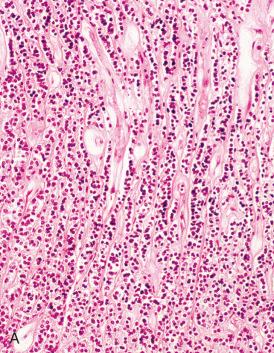
Rarely encountered well-differentiated neuroendocrine neoplasm (carcinoid) exhibits trabecular, organoid, nested, or cordlike growth patterns; minimal or no necrosis; and small uniform cells with round nuclei and finely granular chromatin ( Fig. 15.2 ). Another low-grade neuroendocrine tumor (atypical carcinoid) exhibits the previously stated features with increased mitotic activity (usually 5 to 10 mitoses per 10 high-power fields), a greater degree of nuclear atypia, or conspicuous necrosis ( Fig. 15.3 ).
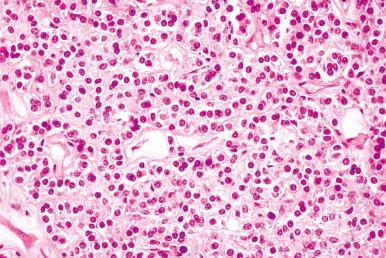
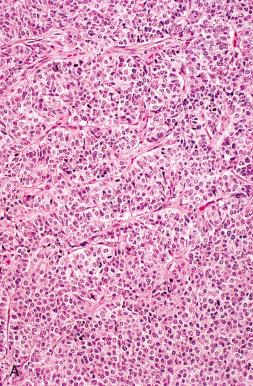
The most prevalent types are the high-grade neuroendocrine carcinomas, including large and small cell neuroendocrine carcinoma, which exhibit necrosis, abundant mitoses (usually more than 10 mitoses per 10 high-power fields), and progressive loss of organoid architecture ( Figs. 15.4 to 15.7 ). In some neuroendocrine carcinomas, an insular/trabecular pattern of growth or discohesive architecture may not be obvious to readily prompt a consideration of neuroendocrine carcinoma on H&E (see Fig. 15.7 ). If the observer is unsure of the distinction, staining with neuroendocrine markers (chromogranin A, synaptophysin, neuron-specific enolase) is advised.
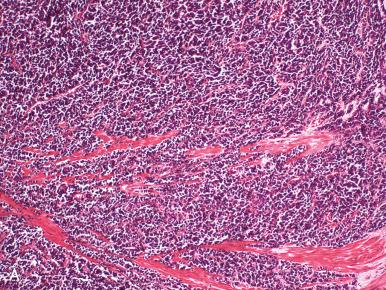
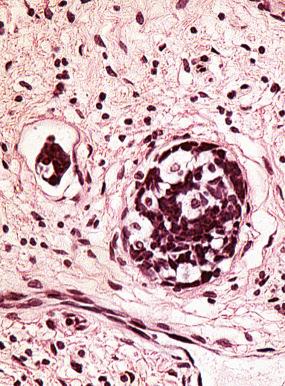
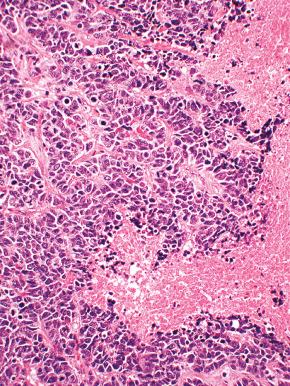
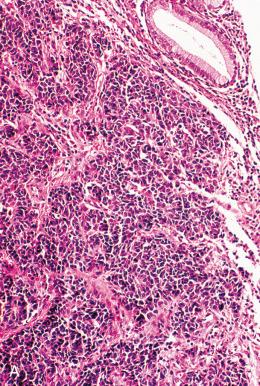
Small cell neuroendocrine carcinoma is morphologically similar to the classic pulmonary “oat cell” carcinoma and demonstrates many of the following features: (1) uniform cell population; (2) hyperchromatic nuclei; (3) a high nuclear–cytoplasmic ratio with nuclear packing (see Fig. 15.4 ); (4) tumor cells arranged in irregular aggregates, often with little cohesion; and (5) occasional rosettes or poorly defined acini. In addition, the nuclei contain coarse to opaque chromatin and, because there is little cytoplasm, they often appear to “mold” with adjacent nuclei. These tumors may also extensively infiltrate the underlying cervical stroma. Additional histologic features more commonly identified in poorly differentiated neuroendocrine carcinoma versus squamous cell carcinoma include (1) vascular invasion (see Fig. 15.5 ), which is observed in as many as 90% of cases by Van Nagell et al. and in 78% of early-stage lesions by Boruta et al.; and (2) conspicuous lack of coexisting inflammation in contrast to most cases of conventional squamous cell carcinoma. Furthermore, by virtue of their rapid growth, broad zones (geographic areas) of necrosis are often seen in these tumors (see Fig. 15.6 ). Large-cell neuroendocrine carcinoma exhibits a similar picture, with a pseudo-trabecular arrangement of cells that have more abundant cytoplasm, large nuclei (similar in nuclear size to small cell non-keratinizing squamous cell carcinoma), and prominent nucleoli (see Fig. 15.7 ).
As noted in the previous section, neuroendocrine neoplasms can be associated with in situ or invasive adenocarcinoma or squamous cell carcinoma. Unless it is of limited extent or of isolated cells, presence of neuroendocrine component should drive the primary histologic classification, because it most likely governs the clinical outcome.
Current data on molecular profiles of cervical neuroendocrine carcinoma are based on single institution-case series. Slightly above 40% of small cell neuroendocrine carcinomas have exhibit loss of heterozygosity in various regions of the short arm of chromosome 3 (3p), and the majority demonstrate vascular endothelial growth factor (VEGF) overexpression. Frumovitz et al. interrogated mutational hotspots in 50 cancer-related genes via next-generation sequencing in 24 cases of small cell neuroendocrine carcinoma. Although no single mutation was found common to most cases, over 40% of cervical small cell carcinoma harbored at least one actionable genetic alteration. Most common mutations were seen in PIK3CA (18%), KRAS (14%), and TP53 (11%), suggesting that targeted therapies may be possible options for management.
The diagnosis of a neuroendocrine carcinoma of the cervix is not a perfect science. It is based primarily on morphology with two caveats:
Not every neuroendocrine carcinoma will be recognized immediately. Some may closely resemble poorly differentiated adenocarcinomas.
Immunostains will not always corroborate the histologic diagnosis, even when fairly certain. Suffice to say that if the pathologist is on the fence, the immunostain (positive or negative) carries the most weight.
The majority of neuroendocrine carcinomas will be (1) positive for low-molecular weight cytokeratin, such as AE1/AE3 and variably positive for cytokeratins 7 and 20 ; (2) diffusely positive for p16 ; and (3) positive for at least one of the neuroendocrine markers, including synaptophysin (60% to 90%), chromogranin (50% to 76%) ( Fig. 15.8 ), CD56 (70% to 90%), and neuron-specific enolase (up to 75%).
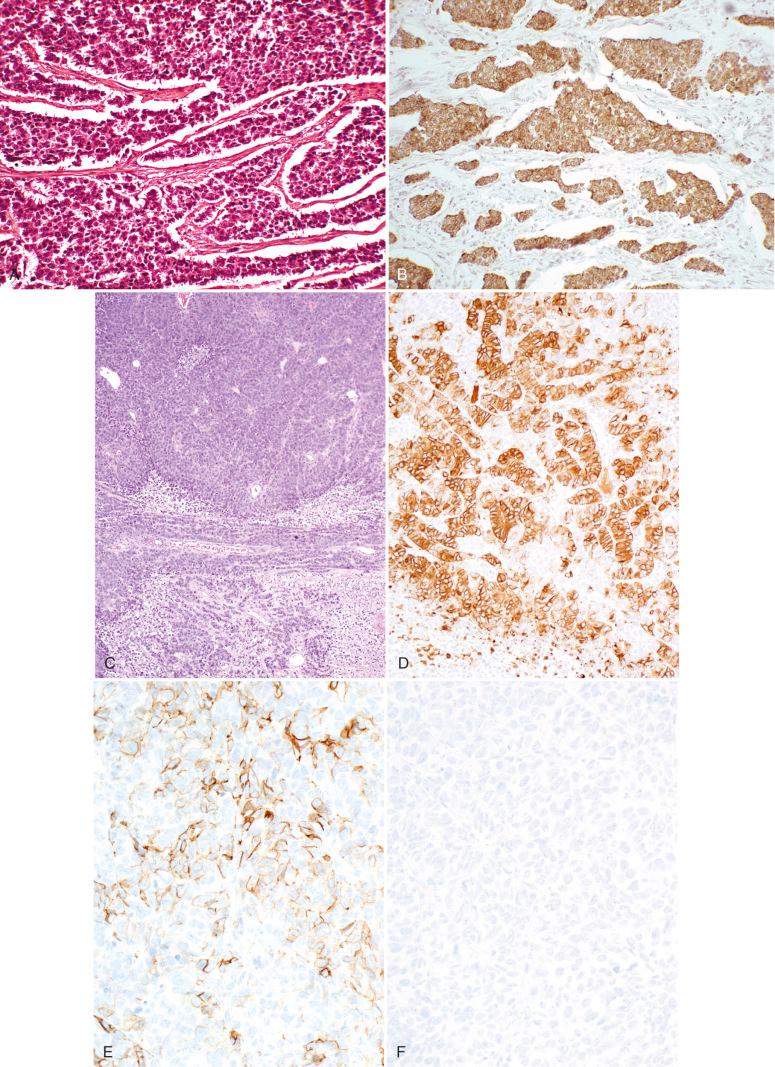
Important points regarding the distinction of neuroendocrine tumors from squamous carcinomas include:
Expression of synaptophysin and chromogranin in large cell neuroendocrine carcinoma is more variable.
Expression for chromogranin and synaptophysin has been detected in up to 20% and 9%, respectively, in non-neuroendocrine carcinoma of the cervix.
One study found that no single parameter would reliably distinguish between the two, including chromogranin staining and testing for HPV-18.
Neuroendocrine carcinomas have the propensity to manifest certain clinical syndromes as a result of peptide hormone production. Immunoreactivity for these peptides have been variably demonstrated in these tumors, such as serotonin, somatostatin, gastrin, glucagon, and pancreatic polypeptide.
As alluded to in the earlier discussion, the differential diagnosis of neuroendocrine carcinoma depends on its diagnostic subcategory.
Carcinoid tumor must be distinguished from primary or metastatic tumor with microacinar architecture ( Fig. 15.9 ). Fortunately, these tumors are very uncommon.
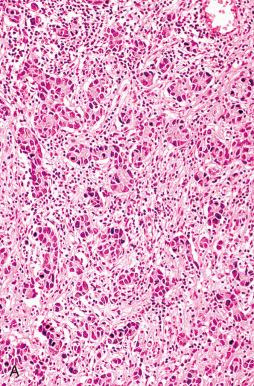
Small and large cell neuroendocrine carcinoma are most easily confused with their morphologic mimics, including (1) small cell nonkeratinizing squamous cell carcinoma ( Fig. 15.10 ), (2) undifferentiated carcinoma, (3) solid adenocarcinoma ( Fig. 15.11 ), (4) primitive neuroectodermal tumor (PNET), (5) lymphoma or granulocytic sarcoma, and (6) melanoma (see the discussion presented later and Table 15.2 ). Separation of these entities will be facilitated if not always completely solved, by immunohistochemistry (see Table 15.2 ). For example, nuclear expression of thyroid transcription factor-1 (TTF-1), a general marker for pulmonary and thyroid primary neoplasms, was reported in one study to be detected (weak to strong reactivity) in up to 70% of cervical small and large cell neuroendocrine carcinomas. Thus TTF-1 expression will not exclude a cervical primary. Likewise, CD99, a nonspecific marker for Ewing/PNET as well as certain lymphomas and a wide range of carcinomas and sarcomas, is detected in up to half of cervical neuroendocrine carcinomas.
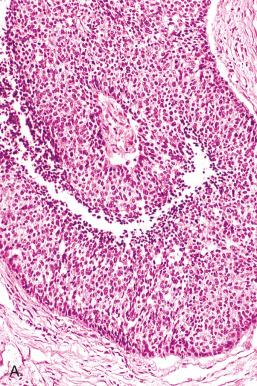
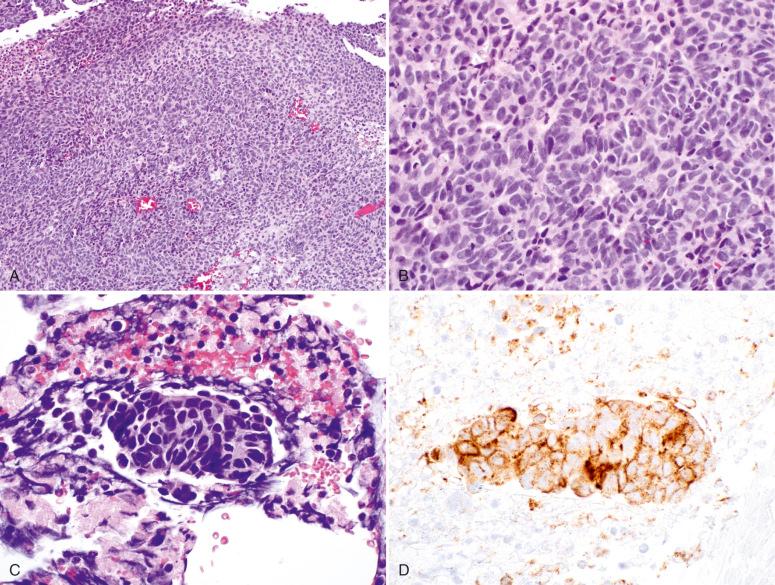
| Diagnosis | Immunophenotype (+) |
|---|---|
| Neuroendocrine carcinoma | Chromogranin (+), synaptophysin (+), p16 (+), p63 (±) |
| Small cell nonkeratinizing squamous carcinoma | p63 (+), p16 (+) |
| Basaloid carcinoma | p63 (+) |
| Peripheral neuroectodermal tumor (PNET) | O13 (p30/32MIC2) (+) |
| Lymphoma | LCA(CD45), CD20(L26), CD3 (+) |
| Granulocytic sarcoma (acute myeloid leukemia [AML]) | Lysozyme, chloracetate esterase (+) |
| Melanoma | SOX10, HMB-45, S-100 (+) |
| Embryonal rhabdomyosarcoma | Myoglobin, desmin, myo-D1, MYF-4 (+) |
The absolute distinction of neuroendocrine carcinomas from poorly differentiated cervical carcinomas may be nearly impossible at times, owing to several factors:
Many neuroendocrine carcinomas arise in association with squamous cell carcinoma or adenocarcinoma ( Fig. 15.12 ).
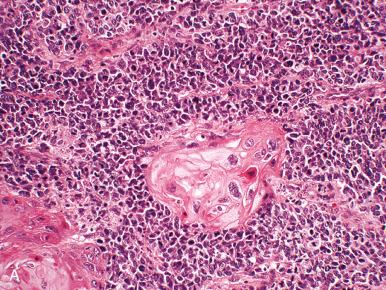
Some growth patterns defy the distinction between glandular and neuroendocrine origin ( Fig. 15.13 ).
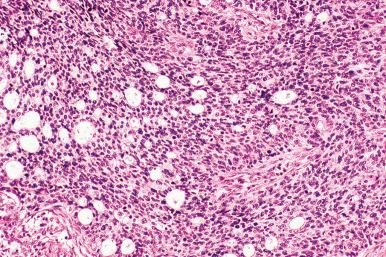
Neuroendocrine carcinoma and other epithelial tumors cannot be distinguished by HPV type or expression of neuroendocrine markers. Squamous differentiation can be helpful up to a point.
SILs are usually associated with small-cell squamous carcinoma but may be associated with neuroendocrine carcinoma.
Expression of p63 has been investigated as a biomarker discriminating squamous from other forms of differentiation in cervical cancers. Wang et al. showed that over 90% of squamous cell carcinoma and 0% of adenocarcinoma in their study were strongly positive (>75%) for p63. Focal to diffuse expression of p63 has been seen in less than 30% to slightly above 40% of cervical neuroendocrine carcinoma across studies. Thus, p63 may be useful for differentiating neuroendocrine carcinoma from squamous cell carcinoma, although it may not distinguish neuroendocrine carcinoma from glandular neoplasia ( Fig. 15.14 ). In most cases, the distinction of squamous from neuroendocrine will be based on histologic features.
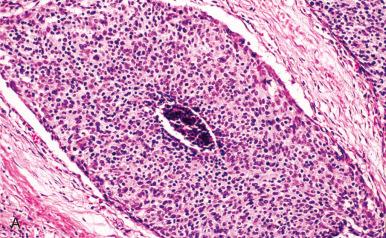
Diagnosis should include histologic subtype as designated by the WHO.
Presence of minor components (e.g., in situ or invasive squamous carcinoma or adenocarcinoma) should also be specified.
Examples:
Small-cell neuroendocrine carcinoma
Poorly differentiated carcinoma predominantly composed of a small cell neuroendocrine carcinoma with a minor gland forming component
Cervical neuroendocrine carcinoma have a poor prognosis. The hazard of death was twofold to threefold higher compared to squamous cell carcinoma in both early-stage (IB to IIA) and late-stage disease (IIB to IVA). For small cell neuroendocrine carcinoma, the overall survival and recurrence-free survival ranged from 11 to 58 months and 9 to 20 months, respectively. The rates reported in literature consistently reflect the aggressive nature of this carcinoma subtype ( Table 15.3 ). The recurrence rate of high-stage cervical small cell carcinoma in one study was nearly 60%; progression-free and overall survival were 17 and 31 months compared to 48 and 49 months for squamous cell carcinoma ( p < 0.05). Most frequent sites of extrapelvic spread are bone, supraclavicular lymph nodes, and lung. Liver and brain were also found to be common metastatic sites.
| Author | Study Design | Histologic Subtype(s): Number of Cases | FIGO Stage: Number of Cases | Survival | Poor Prognostic Factors for Survival |
|---|---|---|---|---|---|
| Lee et al. (2016) | Retrospective study at two institutions (2000-2014) |
|
|
Median overall survival by stage:
|
|
| Embry et al. (2011) | Retrospective study based on data from an institution, SEER database (1973-2005), and case series in literature (1950-2010) | Large cell: 62 |
|
Median overall survival by stage:
|
|
| Wang et al. (2012) | Multi-center retrospective study (1987-2009) | Small cell: 179 |
|
|
|
| Cohen et al. (2010) | Multi-center retrospective study and case series in literature (1979-2005) | Small cell: 188 |
|
5-year disease-specific survival by stage:
|
|
Even patients with early-stage disease might not fare well. Boruta et al. summarized their experience with 11 early-stage (IB to IIA) neuroendocrine carcinomas and included in their pooled analyses an additional 23 similar staged cases in the literature. Over half of the patients presented with lymphovascular invasion (78%) and lymph node metastasis (52%), and the overall 2-year survival rate for the combined 34 patients was only 38%. Alfsen et al. examined overall survival of patients with stage I cervical carcinoma by comparing adenocarcinoma with different nonsquamous histologic subtypes, and reported nearly a fourfold increased hazard for mortality associated with small cell neuroendocrine carcinoma.
Among patients with cervical small cell neuroendocrine carcinoma, (1) advanced stage, (2) larger tumor size, (3) presence of lymph node metastases, (4) pure small cell instead of mixed tumor morphology, and (5) absence of chemotherapy were found to associate with worse clinical outcome (see Table 15.3 ), with advanced stage being the most important prognostic predictor. Chan et al. also reported smoking to be a significant prognostic factor for cervical small cell neuroendocrine carcinoma in their study population. Negative expression of human epidermal growth factor receptor 2 (HER2) coupled with positive epidermal growth factor receptor (EGFR) expression of tumor was observed to be associated with poor survival in cervical neuroendocrine carcinoma. Expression profiles of microRNA in tumors were suggested in one study to be correlated with tumor stage and prognosis.
Outcome data for other neuroendocrine tumor subtypes are limited due to their rare incidence. Embry et al. retrospectively reviewed survival of patients with cervical large cell neuroendocrine carcinoma (N = 62) based on their own institutional experience, case series in literature and database of the Surveillance, Epidemiology and End-Results (SEER) program (see Table 15.3 ). A poor prognosis with early distant spread was seen, similar to findings yielded by prior smaller studies. Advanced disease stage and lack of chemotherapy were similarly found to be prognostic factors for large cell neuroendocrine carcinoma.
The prognosis of typical carcinoid tumor is thought to be better than that of poorly differentiated neuroendocrine carcinomas, although follow-up data are limited. Atypical carcinoid tumor has been reported to follow an aggressive clinical course in case studies. Due to the small number of cases, currently there are no recommendations regarding treatment specific for atypical carcinoid tumor.
Given the rarity of the disease and lack of data from prospective clinical trials, management considerations for cervical neuroendocrine carcinomas mainly draw on regimens for conventional cervical cancer and small cell lung cancer. Although there is no universal consensus to guide optimal treatment, multimodality therapy is favored to achieve best clinical outcome, with recent studies reporting an 80% 3-year disease-free survival among those with early-stage disease who received multimodality treatment.
The Society of Gynecologic Oncologists (SGO) puts forward a clinical document recommending the following treatment algorithm based on currently available data :
Early-stage (I to IIA) disease: Combined modality therapy including radical hysterectomy with lymphadenectomy, as well as etoposide/cisplatin-based adjuvant chemotherapy with or without radiation therapy. If tumors are greater than 4 cm, neoadjuvant chemotherapy may be considered.
Late-stage disease (IIB to IV) or nonsurgical candidates: Combination chemotherapy (etoposide) in addition to radiation therapy.
Widespread metastatic disease or recurrent disease: Chemotherapy with etoposide or VAC/PE (vincristine, doxorubicin [Adriamycin], and cyclophosphamide alternating with cisplatin and etoposide) may be considered.
Targeted therapies are under investigation for neuroendocrine carcinoma in the cervix (e.g., VEGF inhibitor bevacizumab are being evaluated in a phase 2 clinical trial in combination with paxlitaxel, which may have potential survival impact given VEGF overexpression observed in these tumors). As previously discussed, hotspot mutation(s) were identified in significant proportions of small cell neuroendocrine carcinoma. These findings suggest that molecular testing may reveal targeted strategies in patients with recurrent neuroendocrine carcinoma who have limited treatment options.
Undifferentiated carcinoma includes those that lack specific differentiation but are positive for keratins. This subgroup of carcinoma constitutes less than 1% of all primary cervical carcinoma and sarcomas and is usually a diagnosis of exclusion. Histologic mimics include poorly differentiated carcinoma, which can be distinguished by their histologic features and/or immunohistochemical studies confirming their lines of differentiation. For example:
Large cell neuroendocrine carcinoma is a poorly differentiated carcinoma with neuroendocrine cytologic features, positivity for p16 and often synaptophysin and chromogranin.
Poorly differentiated carcinomas with squamous differentiation (p63 positive):
Lymphoepithelial-like carcinoma is a rare variant which is positive for human papillomavirus (HPV) and is often associated with an inflammatory infiltrate.
Spindle cell squamous cell carcinomas are composed of spindle-shaped cells and sometimes osteoclast-like giant cells.
Glassy cell (columnar) carcinoma is considered a poorly differentiated variant of mixed adenosquamous carcinoma. These tumors are recognized by their focal (33% to 85%) or diffuse (≥85%) ground-glass appearance, distinct cell wall that stains with eosin and periodic acid–Schiff (PAS), and often a lymphoplasmacytic infiltrate. Although squamous and glandular features can be rare or absent on H&E, the large tumor cells generally express markers for both squamous cell carcinoma, as well as adenocarcinoma.
Other poorly differentiated tumors (e.g., transitional carcinoma) are difficult to link to a specific line of differentiation but are placed in the squamous group by default.
Occasionally, both intraepithelial and invasive neoplasms will be encountered that do not exhibit specific differentiation by immunohistochemistry. The cases that we have seen in this group have typically been associated with mixed precursor lesions, including stratified mucin-producing intraepithelial lesions (SMILEs), and may form discrete nests with loosely arranged tumors cells or papillary structures lined by undifferentiated carcinoma.
Although metastatic carcinoma to the cervix is exceedingly rare (<1%), possibility of metastatic undifferentiated carcinoma from other primary sites, such as ovary and colon, should also be considered if a separate primary is identified in the patient.
Endocervical polyps are benign glandular proliferations in the cervix. They are common and occur over a wide age range, with a mean in the fifth decade ( Table 15.4 ). Some polyps occur at the endocervical–lower uterine segment junction and harbor both endometrioid (or tubal) and endocervical epithelium. These are variously termed lower uterine segment polyps or mixed endocervical/endometrial polyps .
| Peak Incidence | Fifth Decade |
|---|---|
| Clinical Presentation | |
| Symptomatic | 40% |
| Postmenopausal bleeding | 30% |
| Postcoital bleeding | 12.5% |
| Vaginal discharge | 17.5% |
| Size (Diameter) | |
| Range | 3–40 mm |
| Mean | 10 mm |
| Histologic Outcome | |
| Polyp confirmed | 84.7% |
| Nabothian cyst | 4.3% |
| Leiomyoma | 1.2% |
| Endometrial polyp | 0.3% |
| Endometrial Findings | |
| Cyclic/atrophic | 58.2% |
| Anovulatory | 12.4% |
| Endometrial polyp | 4.4% |
| Atypical hyperplasia | 1.9% |
| Adenocarcinoma | 0.8% |
| Other (e.g., insufficient findings) | 22.3% |
Endocervical polyps are clinically relevant because approximately 40% are symptomatic and often present with bleeding. Given the high frequency of association with menopause, symptomatic polyps require an additional endometrial sampling to exclude an endometrial origin or coincident endometrial pathology to explain the bleeding. Fewer than 0.1% are malignant, and most of these are metastatic uterine carcinoma. Some authors have speculated that unopposed estrogen associated with menopause is responsible for endocervical polyps, but there is no conclusive evidence to support this theory.
The polyps typically have a lobulated or hyperemic surface, and arise within or above the cervical os. They are usually solitary lesions that range in general from a few millimeters to 4 cm in size (with an average of 1 cm).
The majority of endocervical polyps identified clinically are confirmed histologically (see Table 15.4 ). Microscopically endocervical polyps consist of dilated endocervical glands in association with collagenous stroma, as well as prominent vascularity at the base of the polyp. Inflamed or myxoid stroma is common. Infarction due to torsion may be present. A very small percentage (0.1% to 2%) of cases are associated with a squamous (SIL) or columnar adenocarcinoma in situ (AIS) precursor. Squamous metaplasia may be present on surface epithelium.
Endocervical polyps exhibit a wide range of morphologic features reflecting the mixture of glands and stroma with variable predominance of either, including (1) polypoid microglandular hyperplasia in which the epithelium is the predominant component ( Fig. 15.15A ); (2) typical epithelial/stromal polyps (see Fig. 15.15B ); (3) predominately stromal polyps, sometimes with atypical stromal cells, similar to those seen more commonly in the vagina (see Fig. 15.15C and D ); and (4) polyps with atypical features, defined as hypercellular stroma and irregular gland architecture but not fulfilling the criteria for adenosarcoma ( Fig. 15.16 ).
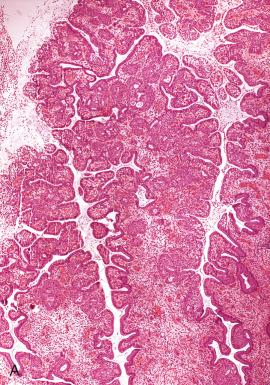
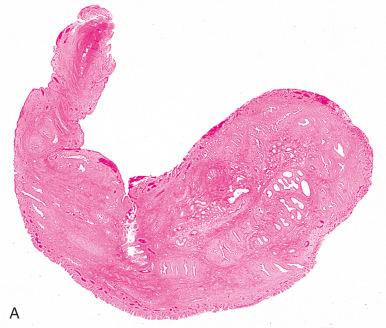
Rare reports of hamartomatous polyps containing benign cartilage and endocervical polyps with extensive formations of sebaceous glands, sweat glands, and hair follicles have been described. Polypoid endometriosis involving the cervix may present as lobulated polyps or masses clinically mimicking endocervical polyps or malignancy, of which distinction can be confirmed by histologic evaluation.
The clinical differential diagnosis on gross examination of a cervical polypoid growth includes benign lesions, such as (1) prolapsed endometrial polyp, (2) endocervical submucosal leiomyoma, (3) adenomyoma, (4) polypoid endometriosis, as well as (5) malignant lesions, including adenosarcoma. Adenosarcoma should be suspected if polyps recur following removal. However, 10% to 20% of benign polyps will also recur. Very large polyps invariably raise the suspicion of malignancy (e.g., sarcoma, adenosarcoma). Nonetheless, in a literature survey of extremely large polyps (10 to 17 cm in diameter), none were malignant. Moreover, reports of adenosarcoma initially misdiagnosed as a benign polyp have not recorded large size as a presenting feature (discussed later). In general, with the exception of a subtle adenosarcoma, most other polypoid lesions can be easily distinguished from benign endocervical polyps.
Treatment of endocervical polyps consists of removal. In patients who are symptomatic (most commonly abnormal bleeding), concurrent endometrial sampling should be performed to exclude concomitant endometrial polyps or other pathology. There is no universal agreement that polyps found incidentally require any action other than outpatient (if possible) removal.
Adenomyoma and polypoid adenomyoma are benign biphasic neoplasms with an endocervical glandular component, as well as a mesenchymal myomatous component. They are much more common in the uterine corpus, but reports have characterized rare cases originating in the cervix. Age of presentation was found to range from 21 to 56 years old with a mean of 40 years old. Patients may be asymptomatic or may present with abnormal bleeding or mucoid discharge.
Become a Clinical Tree membership for Full access and enjoy Unlimited articles
If you are a member. Log in here